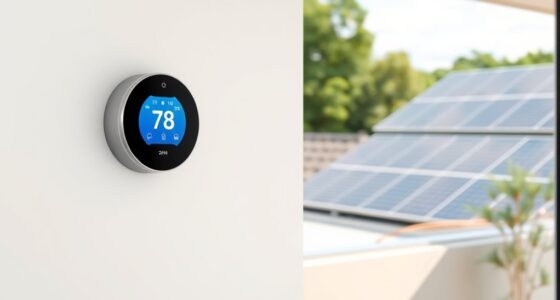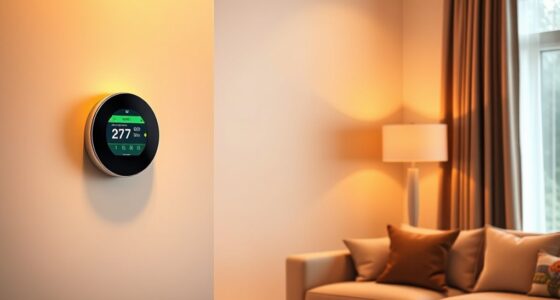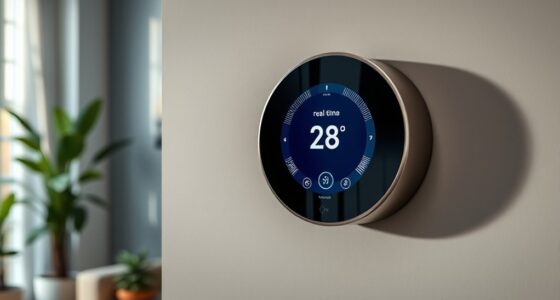To boost energy savings with an aging HVAC system, consider upgrading to a smart thermostat, which learns your schedule and optimizes performance, while allowing remote control. Sealing ductwork prevents conditioned air from escaping, reducing workload and costs. Combining these upgrades can keep your home comfortable and cut energy bills. Regular maintenance, like filter changes and inspections, also helps prolong system life. Keep exploring for more tips to maximize efficiency and savings.
Key Takeaways
- Upgrade to a smart thermostat to optimize system operation and reduce energy waste.
- Seal and insulate ducts to prevent conditioned air loss and improve efficiency.
- Perform regular HVAC maintenance, including filter changes and system inspections.
- Use programmable settings to match heating and cooling to your schedule.
- Consider replacing aging systems with energy-efficient models for long-term savings.

As your HVAC system ages, it often becomes less efficient, leading to higher energy bills and reduced comfort. One effective way to counteract this decline is by upgrading to a smart thermostat. Unlike traditional thermostats, smart thermostats learn your schedule and preferences, allowing you to optimize heating and cooling when you’re at home and reduce energy use when you’re away. They also give you remote control via smartphone, so you can adjust your system anytime, anywhere. This not only prevents unnecessary operation but also guarantees your home stays comfortable without wasting energy. Installing a smart thermostat is typically straightforward, and the savings it offers can quickly offset its initial cost. Additionally, pairing it with your aging HVAC system helps you fine-tune performance and avoid overworking the unit, which can prolong its lifespan.
Another essential step is duct sealing. Over time, ducts develop leaks, which can cause conditioned air to escape before reaching your living spaces. This results in your system working harder to maintain your desired temperature, driving up energy bills. By sealing leaks in your ductwork, you improve overall system efficiency and guarantee that the conditioned air reaches every room as intended. Duct sealing can be done with specialized tapes or mastic sealants, which are inexpensive and easy to apply. You might want to hire a professional to perform a duct inspection, especially if your home has extensive ductwork or hard-to-reach areas. Sealed ducts not only help reduce energy costs but also improve indoor air quality, as less dust and debris escape into your living spaces. Plus, with efficient ductwork, your aging HVAC system won’t have to work as hard, which can delay the need for costly repairs or replacement. Incorporating duct maintenance into your routine can further enhance system performance.
Together, smart thermostats and duct sealing form a powerful combination for maximizing the efficiency of your aging HVAC system. The thermostat ensures that your system isn’t running unnecessarily, while duct sealing guarantees that the conditioned air you pay for actually stays inside your home. These upgrades are cost-effective and relatively simple to implement, making them excellent starting points for improving energy savings. Keep in mind that regular maintenance, like changing filters and scheduling inspections, further supports your efforts to reduce energy consumption and extend your system’s life. By taking these proactive steps, you’ll not only cut down on energy bills but also enjoy a more comfortable home environment, even as your HVAC system ages.
Frequently Asked Questions
How Often Should I Schedule Professional HVAC Maintenance?
You should schedule professional HVAC maintenance at least once a year to keep your system running efficiently. Regular tune-ups improve indoor air quality, ensuring better ventilation and cleaner air. During maintenance, ask your technician about energy audits to identify areas where your system can save energy. Consistent servicing prevents breakdowns, prolongs your HVAC’s lifespan, and helps you maintain ideal indoor air conditions while reducing energy costs.
What Are Signs My HVAC System Needs Replacing?
If your HVAC system’s lifespan feels like it’s stretching into infinity, it might actually be time for a replacement. Signs include skyrocketing energy bills, inconsistent temperatures, strange noises, frequent breakdowns, or if repairs cost more than half of a new system. Don’t ignore these replacement indicators—they signal your system is past its prime and could soon leave you in the cold. Upgrading now guarantees comfort and efficiency.
Can Thermostat Upgrades Improve Energy Efficiency?
Upgrading to smart thermostats or programmable thermostats can substantially boost your energy efficiency. These devices let you set customized schedules, avoid unnecessary heating or cooling when you’re away, and optimize temperature control. With a smart thermostat, you can even control your system remotely via your smartphone. By making these upgrades, you’ll reduce energy waste, lower utility bills, and enjoy more precise climate management inside your home.
Are DIY Repairs Effective for Aging HVAC Units?
Think of DIY repairs as patching a leaking boat—they might hold temporarily but often aren’t enough for long-term success. When it comes to aging HVAC units, DIY fixes can improve repair effectiveness initially, but they rarely address underlying issues. You risk wasting time and money on quick fixes that won’t last, so consider consulting a professional for more reliable, efficient repairs that truly extend your system’s lifespan.
What Long-Term Costs Are Associated With System Replacement?
Replacing your HVAC system involves long-term costs like upfront expenses, installation fees, and potential future repairs. You should do a thorough cost analysis to compare replacement options, considering energy efficiency improvements that could save money over time. Although initial costs can be high, investing in a modern, efficient system often reduces energy bills and maintenance costs, making it a wise long-term financial decision.
Conclusion
Just like the wise owl guards its nest, keeping your aging HVAC system well-maintained guarantees it continues to serve you efficiently. By implementing these energy-saving tips, you extend its life and save money, all while reducing your environmental impact. Remember, even the strongest oak needs care to thrive—your HVAC system is no different. Stay proactive, stay efficient, and let your home be a proof of your smart choices. Don’t wait for the storm—prepare today.









